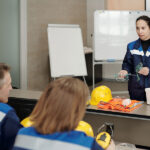When it comes to workplace safety, the most effective solutions aren’t found in sophisticated personal protective equipment or comprehensive emergency response plans—though these certainly have their place. The truly transformative approach begins much earlier: during the design phase, before hazards ever enter the workplace.
This concept—known as Prevention through Design (PtD), Safety by Design, or Design for Safety—represents a fundamental shift in how organizations approach workplace safety. Rather than asking “How do we protect workers from this hazard?” the question becomes “How do we eliminate this hazard entirely?”
The Hierarchy of Controls: Design at the Top
Safety professionals have long recognized the hierarchy of controls as the framework for addressing workplace hazards. From most to least effective, these controls are:
- Elimination – Physically removing the hazard
- Substitution – Replacing the hazard with something less dangerous
- Engineering Controls – Isolating people from the hazard
- Administrative Controls – Changing how people work
- Personal Protective Equipment – Protecting workers with PPE
The first two levels—elimination and substitution—are most effectively implemented during the design phase, whether designing facilities, selecting equipment, or establishing workflows. Yet many organizations default to lower-level controls, essentially designing in hazards and then trying to manage them through less effective means.
The Business Case for Safety Through Design
Beyond the ethical imperative to protect workers, there are compelling business reasons to prioritize safety in the design phase:
- Cost Effectiveness: Modifications during design typically cost 10% of what they would cost once construction is complete, and just 1% of what remediation costs after an incident occurs.
- Operational Efficiency: Processes designed with safety built in generally operate more smoothly, with fewer disruptions and less downtime.
- Regulatory Compliance: Many newer regulations increasingly emphasize proactive hazard elimination rather than reactive protection measures.
- Worker Satisfaction and Retention: Facilities and processes that inherently minimize physical strain and risk factors demonstrate a tangible commitment to employee wellbeing.
Practical Applications Across the Workplace
Safety through design applies across multiple dimensions of the workplace:
Facility Design
When planning new construction or renovations, safety considerations should influence basic architectural decisions:
- Optimizing lighting to reduce eye strain and prevent accidents
- Designing ventilation systems that effectively remove airborne contaminants
- Including adequate space for safe equipment operation and maintenance
- Selecting flooring materials that minimize slip hazards while meeting operational needs
- Incorporating ergonomic principles into workstation layouts
Equipment Selection and Modification
Equipment purchasing represents a critical opportunity to eliminate hazards before they enter the workplace:
- Choosing machinery with integrated guarding systems rather than requiring retrofitted guards
- Selecting tools that minimize vibration, noise, and awkward postures
- Requiring equipment with control systems that prevent accidental activation
- Evaluating maintenance requirements to ensure safe accessibility for service
- Considering noise levels and potential for substituting quieter alternatives
Process and Workflow Design
How work is organized can create or eliminate hazards:
- Designing workflows to minimize manual material handling
- Creating processes that eliminate the need for confined space entry
- Establishing production methods that reduce exposure to hazardous substances
- Developing systems that minimize time pressure and worker fatigue
- Building quality checks that prevent unsafe workarounds
Implementing Safety Through Design
Organizations looking to implement safety through design should consider these practical steps:
- Involve multiple perspectives: Include safety professionals, engineers, operators, and maintenance personnel in design discussions.
- Establish clear design criteria: Define specific safety requirements that all new designs must meet.
- Use risk assessment methodologies: Systematically identify potential hazards during the design phase.
- Learn from experience: Track incidents and near-misses to inform future designs.
- Consider the entire lifecycle: Evaluate safety implications during normal operation, maintenance, and eventual decommissioning.
From Reactive to Proactive
The shift toward safety through design represents a broader evolution from reactive to proactive safety management. Rather than constantly responding to risks, forward-thinking organizations are designing workplaces where many traditional hazards simply don’t exist.
This approach doesn’t eliminate the need for other safety measures—training, procedures, and protective equipment will always have their place. But by addressing hazards at their source, during the design phase, organizations can create fundamentally safer workplaces where protection is built in, not added on.



